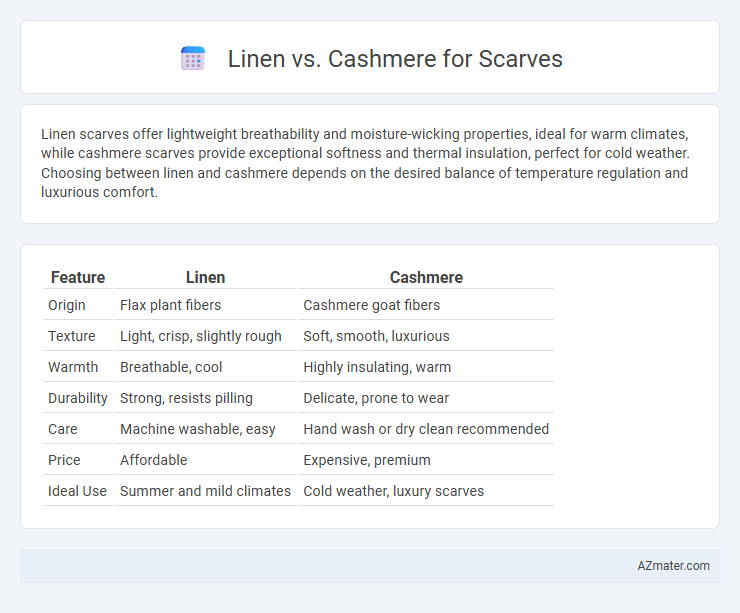Linen scarves offer lightweight breathability and moisture-wicking properties, ideal for warm climates, while cashmere scarves provide exceptional softness and thermal insulation, perfect for cold weather. Choosing between linen and cashmere depends on the desired balance of temperature regulation and luxurious comfort.
Table of Comparison
| Feature | Linen | Cashmere |
|---|---|---|
| Origin | Flax plant fibers | Cashmere goat fibers |
| Texture | Light, crisp, slightly rough | Soft, smooth, luxurious |
| Warmth | Breathable, cool | Highly insulating, warm |
| Durability | Strong, resists pilling | Delicate, prone to wear |
| Care | Machine washable, easy | Hand wash or dry clean recommended |
| Price | Affordable | Expensive, premium |
| Ideal Use | Summer and mild climates | Cold weather, luxury scarves |
Introduction: Comparing Linen and Cashmere Scarves
Linen scarves offer lightweight breathability and moisture-wicking properties, ideal for warmer climates, while cashmere scarves provide exceptional softness and superior insulation for colder weather. Linen fibers are made from flax plants, promoting durability and a natural texture, whereas cashmere is derived from the undercoat of cashmere goats, known for luxurious warmth. Choosing between linen and cashmere scarves depends on your climate preferences and desired balance between temperature regulation and plush comfort.
Material Overview: What is Linen?
Linen is a natural fiber derived from the flax plant, known for its durability, breathability, and lightweight texture, making it ideal for warm-weather scarves. Unlike cashmere, linen has a crisp texture and provides excellent moisture-wicking properties, keeping the skin cool and dry. Its eco-friendly production and biodegradable nature enhance linen's appeal as a sustainable material choice for scarves.
Material Overview: What is Cashmere?
Cashmere is a luxury natural fiber derived from the undercoat of Cashmere goats, renowned for its exceptional softness, warmth, and lightweight feel. This fine wool offers superior insulation compared to standard wool, making Cashmere scarves highly prized for cold weather comfort and elegance. The delicate fibers require careful processing, contributing to the exclusivity and higher price point of Cashmere scarves relative to other materials like linen.
Softness and Comfort: Linen vs Cashmere
Cashmere scarves offer unparalleled softness and luxurious comfort, thanks to their fine, silky fibers that gently envelop the skin, making them ideal for sensitive skin types. Linen scarves, while breathable and lightweight, have a coarser texture that provides a crisp feel but may not match the plush softness of cashmere. When prioritizing softness and comfort, cashmere remains the superior choice for warmth and gentle touch in scarves.
Breathability and Warmth Comparison
Linen scarves offer superior breathability due to their natural moisture-wicking fibers, making them ideal for warm weather and preventing overheating. Cashmere scarves provide exceptional warmth and insulation, trapping heat efficiently while remaining lightweight for cold climates. Both fabrics serve distinct purposes, with linen excelling in ventilation and cashmere in thermal retention for varying seasonal needs.
Durability and Longevity
Cashmere scarves are prized for their softness and warmth but require delicate care to maintain durability, as the fine fibers can easily pill and wear over time. Linen scarves offer superior longevity due to their strong, natural fibers that resist abrasion and become softer with each wash while maintaining structural integrity. Choosing linen ensures a more durable scarf suited to frequent use, whereas cashmere provides luxury at the expense of long-term resilience.
Style and Aesthetic Appeal
Linen scarves offer a crisp, natural texture with a lightweight, breathable weave that enhances a casual yet sophisticated style ideal for warm weather. Cashmere scarves provide a luxurious, soft feel with a smooth drape that elevates any outfit with timeless elegance and warmth, perfect for colder seasons. The choice between linen and cashmere fundamentally influences the aesthetic appeal, balancing between airy refinement and plush opulence.
Maintenance and Care Requirements
Linen scarves demand minimal care, with machine washing in cold water and air drying to prevent shrinkage, while cashmere scarves require gentle hand washing or dry cleaning to maintain their soft texture and avoid fiber damage. Linen's natural durability and resistance to pilling make it easier to maintain over time, whereas cashmere needs careful storage in breathable bags to prevent moth infestations. Proper maintenance ensures linen scarves remain crisp and lightweight, and cashmere retains its luxurious softness and warmth.
Price and Value for Money
Linen scarves typically offer a budget-friendly price point, making them accessible for everyday wear while delivering durability and breathability. Cashmere scarves command a higher price, reflecting their luxury status, exceptional softness, and insulation properties, which justify the investment for long-term comfort and elegance. Evaluating value for money depends on budget and desired qualities; linen excels in affordability and practicality, whereas cashmere provides superior warmth and a premium feel.
Choosing the Best Scarf: Linen or Cashmere?
Linen scarves offer exceptional breathability and durability, making them ideal for warmer climates and everyday use. Cashmere scarves provide superior softness and insulation, perfect for cold weather and luxurious comfort. Choosing between linen and cashmere depends on desired warmth, texture, and occasion, with linen favored for lightweight versatility and cashmere for premium warmth.

Infographic: Linen vs Cashmere for Scarf
 azmater.com
azmater.com